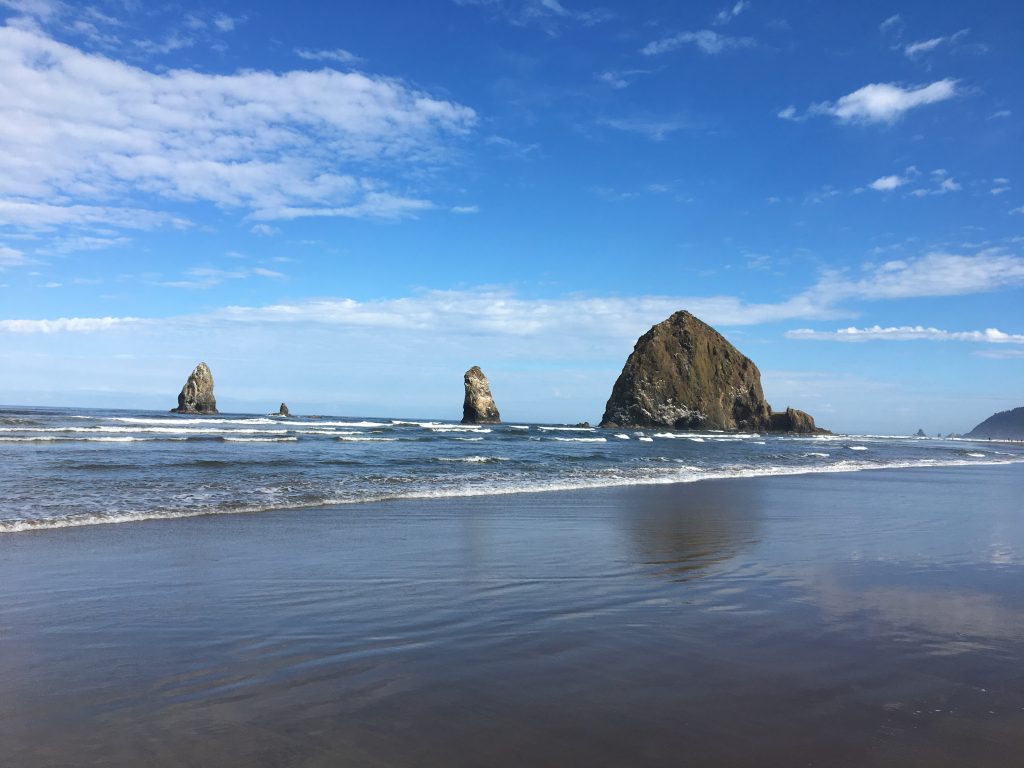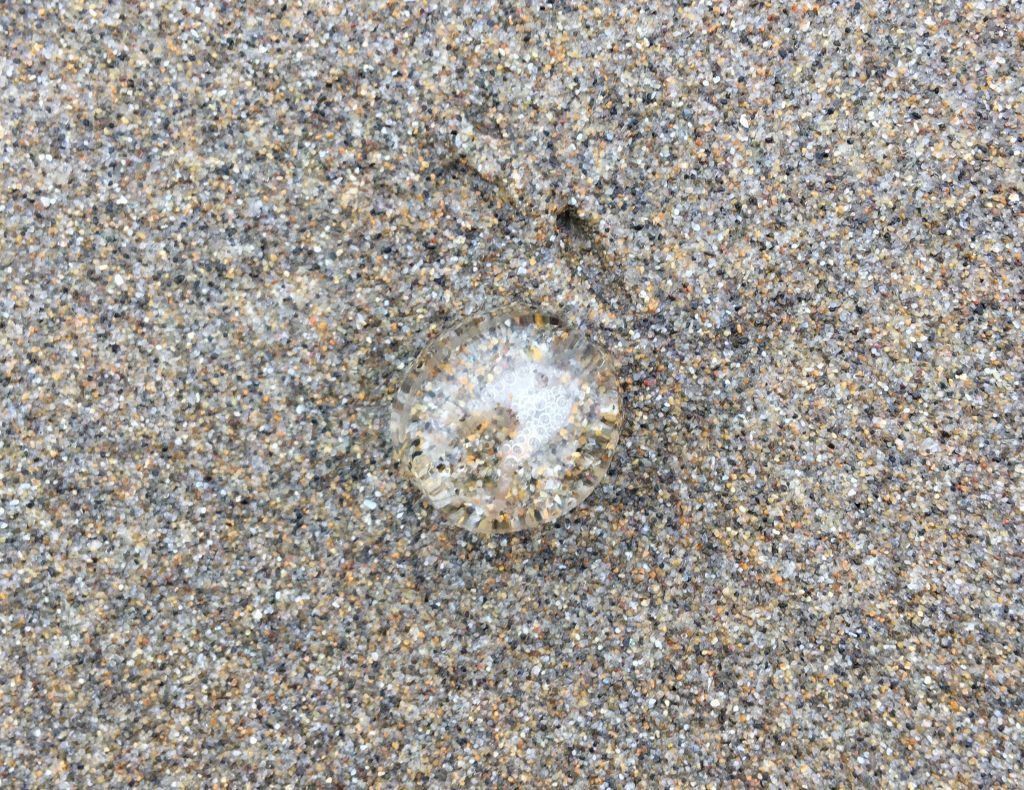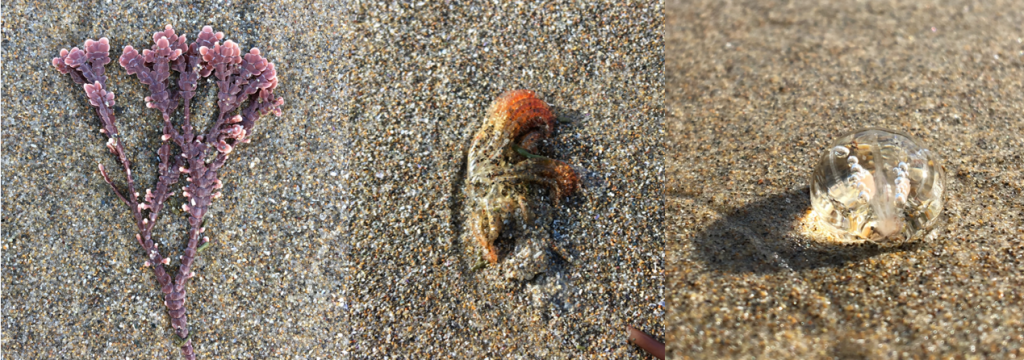***ALERT: Last week of data collection! If you have ever visited Cannon Beach, you are eligible to take the survey and enter to win a bunch of HRAP swag and Sleepy Monk coffee. Just click here to start! ***

During my few weeks of work with the Haystack Rock Awareness Program, I tried to walk to work as much as possible while staying just past Tolovana Park in Cannon Beach. I learned that the crusty, salted line of debris caused by the ebbing tide is called the wrack line; it is here that I have found amazing treasures and intriguing marine life. Identifying the organisms in the wrack line has helped me to become a better Environmental Interpreter as it has made me more knowledgeable of the marine life specific to this region. In most traditional Hawaiian practices the moon phase is very important to kilo, or observations, made in the natural environment. Thus, the following kilo include the Hawaiian names for the different faces of the moon.
ʻOle Pau, June 23, 2019
My first walk along the wrack line was an experiment to determine how long a commute would take on foot. As I stepped into the sand, the first observation made was the sound — the sand squeaks! Lifting my shoes out of the soft, powdery grains proved laborious, so I found a piece of drift wood to sit on and removed my footwear. Much better! Note taken: just like in Hawaiʻi, it is more efficient to walk barefoot in the sand. At first I was committed to being fully present and experiencing the beach through only organic eyes and not a screen…but this attempt failed when I saw the green, sludgy sea foam I had read about. Mai hopohopo mai — do not worry folks, it is not pollution!

Diatoms often cause the water to be a greenish color and give bubbles that develop on the shore a greenish tint. Moving on I found a strange arthropod that resembled a marine pill bug, which was being feasted on by other flea like creatures. This was my first run in with mole crabs and their babies — that bite! While attempting to film the frenzy I felt little pinches on my feet that felt like ant bites. Slightly shrieking and dancing away, I know now to move quickly when I see the hopping baby mole crabs so as to not give them time to munch on me. When I finally arrived at Haystack Rock, I found the first of many deceased birds that I would photograph. The contrast of the bustle of visitors at Haystack Rock fawning over the puffins and the sea stars with the floppy corpse of the murre fascinated me.

Kāloa Kū Kahi, June 24, 2019
When I stepped on to the beach in the morning, Haystack Rock could barely be seen in the distance through the mist. As I approached were the sea meets the shore, I noticed several progressions of wrack line. Dried lines of salt littered with bits of shell and detritus were evidence of the ebbing tide, which would continue to drop until 11:57 am that morning. I soon stumbled on to the shell of a key hole limpet and a sea gooseberry.

Finding the keyhole limpet shell was particularly exciting because it reminded me so much of the opihi we have at home, except for the aperture at the apex of the shell’s point. When I got within the vicinity of Haystack Rock, I came across a pile of gull, the dry, fluffy feathers making it evident that the bird was attacked in air or on land and did not wash up with the tide. The common murre from yesterday was still there. Before leaving the wrack line, my eye spied bright blue debris — plastic! But alas when I picked it up I realized it was bits of egg shell — common murres can have blue eggs!

Conditions on the walk home were quite a contrast from that morning: blue bird skies, streaky cirrus and sand toasted by the sun. A sea nettle was the first of my discoveries in the wrack line, followed by a lady bug (?!?!), dead manʻs fingers — an algae, not actually, LOTS of dead sea birds and their parts, a tangle of bull kelp and finally some live gulls scavenging the rising tide.

Kāloa Pau, June 26, 2019
I stepped on the beach at 8:04 am to walk to work as the tide just turned from a high of 5.8 ft at 7:45 am. My first wrack line specimen for the day was a piece of coralline algae, of which I have only seen the crustose variety. The structure reminded me of the Halimeda that we have back home, a calcifying algae that contributes greatly to our calcareous sand beaches. Not far from the coralline algae was a clump of feathery cirri from a gooseneck barnacle. As I continued down the beach, bundles of cirri were a common find. I found a key hole limpet shell and a sea gooseberry again, and an intact moon jelly. I also found iridescent sea foam and tube worm casing. The highlight of this walk was definitely the flock of pelicans that were slowly making their way to the Needles. I was able to catch a video of one in flight as it searched for edibles in the water.


My first find on the walk home was a sand hopper, which cowered from the shadow of my phone as I tried to film it. Tube worm casing and crab molts littered the wrack line as the tide continued to rise from its bottom out at 1.7 ft at 1:40 pm. I also found an ostrich plume hydroid attached to some driftwood, a mole crab filled with bright orange eggs and what looked like akulikuli, or pickle weed. Before I made my way up through the dry sand to the beach access, I spied the biggest sea gooseberry I had found yet — it was the size of a quarter and I was lucky to snag a picture before the ocean reclaimed it.


Lono, June 28, 2019
The beach was crisp even though the sun was out when I got there. The tide was rising to 6.0 ft at 10:08 am from a low of 0.9 ft at 4:01 am. Last nightʻs rain made the wrack line difficult to differentiate from the rest of the sand, but I did find my third and biggest keyhole limpet shell. There are many limpets at Haystack Rock, but I have yet to see a live keyhole limpet — I have a feeling it does not do well in the intertidal zone because its aperture allows for the release of water, which so many intertidal organisms strive to maintain with their bodies as the tide recedes.

Another evidence of last night’s rain was runoff flowing from an outlet that usually does not make it to the sea. I often see children playing in the runoff at the Gower St. and the Tolovana Park outlets — not a good idea as this water usually has a high fecal bacteria count. Ick!

On my walk home, I found many shells. The olive snail shells were an awesome find — all empty and free of critters, of course. The smaller ones were dispersed in a patch of biogenous sand, which I was very excited to find. I also found a strand baby sea star. Not knowing what to do, I texted my mentor for help. For future reference: if you find a sea star stranded in the sand do NOT pick it up directly, either use something to shovel in up or pick up the sand around/underneath it. Then, if it is not already upside-down, turn it over: if is is hollow in the middle it is dead, but if it has tube all its tube feet it lives! Next, place it right side up on a rock nearby and hope it makes it. Or you can just leave it alone and let nature do its thing.



What a beautiful and informative post Honour!! Your photos are wonderful, it’s amazing how dynamic a simple walk up and down the beach becomes when you’re focusing on your surroundings. I just took your survey, and it seemed like a great mix of questions – I think the results should be very useful for HRAP. And thanks for sharing the best way to rescue a sea star, good to know in case I ever encounter a stranded one!